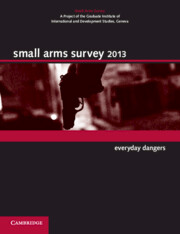Book contents
- Frontmatter
- Foreword
- Contents
- About the Small Arms Survey
- Notes to readers
- Acknowledgements
- Introduction
- Chapter 1 Everyday Dangers: Non-conflict Armed Violence
- Chapter 2 Too Close to Home: Guns and Intimate Partner Violence
- Chapter 3 Turning Points: Gang Evolution in Nicaragua
- Chapter 4 Guns in the Family: Mafia Violence in Italy
- Chapter 5 Survival at Stake: Violent Land Conflict in Africa
- Chapter 6 Trend Lines: Armed Violence in South Africa pages 132 to 137
- Chapter 6 Trend Lines: Armed Violence in South Africa pages 137 to 159
- Chapter 7 Second Wind: The PoA's 2012 Review Conference pages 160 to 168
- Chapter 7 Second Wind: The PoA's 2012 Review Conference pages 169 to 177
- Chapter 8 Trade Update: Authorized Small Arms Transfers
- Chapter 9 Burning the Bullet: Industrial Demilitarization of Ammunition pages 186 to 199
- Chapter 9 Burning the Bullet: Industrial Demilitarization of Ammunition pages 200 to 217
- Chapter 10 ‘Infernal Machines’: Improvised Explosive Devices
- Chapter 11 Price Watch: Arms and Ammunition at Illicit Markets pages 250 to 268
- Chapter 11 Price Watch: Arms and Ammunition at Illicit Markets pages 269 to 281
- Chapter 12 Captured and Counted: Illicit Weapons in Mexico and the Philippines pages 282 to 302
- Chapter 12 Captured and Counted: Illicit Weapons in Mexico and the Philippines pages 302 to 317
- Index
Chapter 9 - Burning the Bullet: Industrial Demilitarization of Ammunition pages 200 to 217
Published online by Cambridge University Press: 05 June 2014
- Frontmatter
- Foreword
- Contents
- About the Small Arms Survey
- Notes to readers
- Acknowledgements
- Introduction
- Chapter 1 Everyday Dangers: Non-conflict Armed Violence
- Chapter 2 Too Close to Home: Guns and Intimate Partner Violence
- Chapter 3 Turning Points: Gang Evolution in Nicaragua
- Chapter 4 Guns in the Family: Mafia Violence in Italy
- Chapter 5 Survival at Stake: Violent Land Conflict in Africa
- Chapter 6 Trend Lines: Armed Violence in South Africa pages 132 to 137
- Chapter 6 Trend Lines: Armed Violence in South Africa pages 137 to 159
- Chapter 7 Second Wind: The PoA's 2012 Review Conference pages 160 to 168
- Chapter 7 Second Wind: The PoA's 2012 Review Conference pages 169 to 177
- Chapter 8 Trade Update: Authorized Small Arms Transfers
- Chapter 9 Burning the Bullet: Industrial Demilitarization of Ammunition pages 186 to 199
- Chapter 9 Burning the Bullet: Industrial Demilitarization of Ammunition pages 200 to 217
- Chapter 10 ‘Infernal Machines’: Improvised Explosive Devices
- Chapter 11 Price Watch: Arms and Ammunition at Illicit Markets pages 250 to 268
- Chapter 11 Price Watch: Arms and Ammunition at Illicit Markets pages 269 to 281
- Chapter 12 Captured and Counted: Illicit Weapons in Mexico and the Philippines pages 282 to 302
- Chapter 12 Captured and Counted: Illicit Weapons in Mexico and the Philippines pages 302 to 317
- Index
Summary
REGULATIONS, STANDARDS, AND OVERSIGHT
There is currently no common international or European standard, legislation, or compliance mechanism that specifically addresses ammunition demilitarization by commercial contractors.
This may complicate, and in some cases prevent, the development of a systematic, multinational approach to ammunition demilitarization. Within NATO, Standardization Agreement 4518 provides a brief—and outdated—overview of the demilitarization process and available techniques, but it was not written to provide industry standards (NIAG, 2010, p. 171). National legislation usually does not regulate the destruction of military ammunition by civilian industrial contractors. To process military ammunition, industrial contractors must therefore apply a patchwork of civilian explosives industry legislation and for certain activities, such as OB and OD, they may adapt military guidance.
Seemingly unrelated legislation and civilian regulations affect the demilitarization industry indirectly. Changes to regulations in the areas of environment, safety, and staff training requirements can have effects on demilitarization practices. There is also a complex framework of regional, national, and even local rules subjecting demilitarization activities to various local permits and licences. In the United States, for example, the demilitarization of munitions requires compliance with numerous local, state, and federal regulations, most of which require air emissions permits and chemical release reports (Thompson, Kennedy, and Nordquist, 2004).
US and Western European contractors usually know these constraints well because they have a direct impact on their business. However, client governments and national programmers may find this regulatory framework complex and opaque.
- Type
- Chapter
- Information
- Small Arms Survey 2013Everyday Dangers, pp. 200 - 217Publisher: Cambridge University PressPrint publication year: 2013



